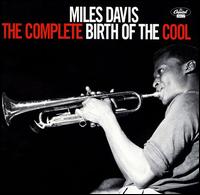 Miles Davis Certainly one of the most overrated albums in the history of music criticism, Miles Davis's "classic," "legendary" and "important" nonet session is, on my word, remarkably boring music. Originally recorded in 1948 and repackaged in album format as The Birth of the Cool (mainly to capitalize on the cool jazz trend of the 50s, which Miles is credited with originating), this CD presents the album in its original format, digitally remastered, and supplemented with previously unreleased live tracks from the nonet's few dates as a working group. I'm a pretty big fan of cool jazz in general, but this is a case of the kids being "cooler" than the parents. Sure, without this music, cool jazz as we know it would never have happened. Sure, Miles and arranger Gil Evans demonstrated new things that could be done with a small big band, and this would decidedly influence the amazing recordings Miles & Gil would make later on. And sure, this is the most innovative, unique jazz that came out of 1948 – but we're talking about 1948 here! Call me snooty, but give me 1968 anyday, or even 1988. Surely 1978! Okay, I'll settle for 1958! Fine, fine, 1998. I'm just saying that the relevance of Birth of the Cool to me at this moment is minimal at best. Take it from a committed Miles fan who has long struggled with the man's many phases – this is just not all it's cracked up to be. Part of the problem with The Complete Birth of the Cool is that it's too complete. In its original form, the album is pleasant enough, breezy Sunday afternoon jazz, but the addition of the live material effectively doubles the original length – leaving the lasting impression of a grandfather who has some interesting stories, but just can't shut his yap. I know lots of musicians who love the album, and most jazz fans over 50 swear by it, but I wouldn't place it in my Top 1500. The trouble is, it's the sort of album where I find myself thinking "That's pretty good considering how early it was recorded." I mean, in the context of jazz history it's impossible to deny the influence these sessions had – creating an alternative to bebop and inadvertently spawning a whole movement. But equal argument could be made that Miles would have spawned that movement anyway, or that the nonet sessions were integral on his development in spawning "cool jazz" as a new style. Taken on its face, though, the album is good, sprightly jazz played by a dream band – in 1948. You can't top the names (Miles & Gil, Gerry Mulligan, Kai Winding, J.J. Johnson, Lee Konitz, John Lewis, Max Roach & Kenny Clarke, plus several others who never became huge stars) but an album recorded by those same people 15 or 20 years later would have been much preferable. I hold on to the music until it hits the last track of the regular album, "Darn That Dream," featuring Kenny Hagood on vocals in what you'd imagine as the stereotypical 40s radio show performance style – very lame unless you're over 80 and still like to masturbate thinking of the "great crooners." (Oof, where'd that come from?) It's at that point that I lose the medium interest I had, and I'm nowhere near in the mood to sit through another 40 minutes of music, much less acetate-quality radio bootlegs. To their credit, Blue Note/Capitol Jazz has done an impeccable job of packaging this, with informative liner notes and a great slipcase, but I must say I have no interest in putting this on. It's one of those albums that gets so heralded that people feel compelled to buy it for its "importance" – pah! I say, take it down. It's not all that; I wouldn't even rank it in my top 20 favorite "cool" jazz albums based on how much I like to listen to it. Sure, your grandpa got a Purple Heart; I still think he talks too much and smells kind of funny.
Review by Ohh Henri |